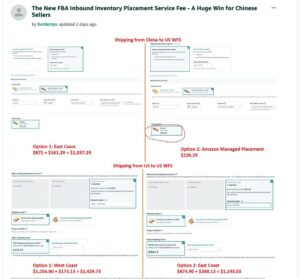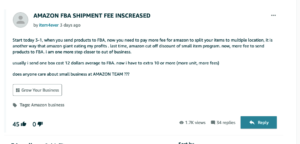
New Amazon Coupon Pricing Requirements
- Starting March 12, 2024, Amazon introduces new coupon pricing requirements to enhance customer trust and seller experience. Coupons must offer a 5%-50% discount, and products need a sales history to qualify, ensuring promotion prices are lower than the “was price” or recent lowest. Non-compliance results in coupon ineligibility. Actions for sellers include building sales history for new products, adjusting discounts to meet the specified range, and ensuring promotional prices are competitive. This change mandates that project managers guide clients to comply with these requirements, emphasizing the importance of sales history and competitive pricing for coupon eligibility.
Adapting to Amazon’s New FBA Inbound Placement Service Fee
- Amazon’s new FBA inbound placement service fee, effective March 1, 2024, introduces a cost for sellers using Amazon’s distribution network to strategically place inventory closer to customers, thereby optimizing delivery speeds and reducing shipping costs. This change affects sellers by introducing fees based on product size, weight, and chosen shipment strategy: minimal shipment splits (a fee for fewer locations), partial shipment splits (reduced fees for multiple locations), and Amazon-optimized shipment splits (no fee for four or more locations), with variable costs depending on the fulfillment center’s location.
- Sellers must now carefully plan their shipments to manage these additional costs effectively. Considerations include evaluating the balance between distribution costs and the benefits of faster delivery to customers. To mitigate these new expenses, sellers can explore Amazon’s partial or optimized shipment options that offer reduced or no fees for distributing inventory across multiple locations. Additionally, new seller incentives, such as credits for the inbound placement service fee, offer an opportunity to reduce initial costs. Sellers are encouraged to stay informed on these changes and adapt their logistics strategies accordingly to maintain profitability and competitive edge on the platform.
Adaptation to Amazon’s FBA Inbound Placement Service Fee: Key Insights for Sellers
- With the introduction of Amazon’s FBA inbound placement service fee, set to take effect on March 1, 2024, the landscape for sellers is changing. This fee, part of Amazon’s strategy to enhance efficiency and delivery speed by distributing inventory closer to customers, directly influences sellers’ operational costs and logistics planning. The fee structure varies depending on the shipment option selected—minimal, partial, or Amazon-optimized shipment splits—and is also influenced by product dimensions, weight, and the destination fulfillment center.
- Seller Community Feedback:
- Concern Over Discrimination Against US Sellers: A seller highlighted a perceived disadvantage for US-based sellers compared to those shipping from China. In simulations, shipments originating from China incurred no placement service fee under the Amazon Managed Placement option, whereas US sellers faced higher fees for similar services. This discrepancy raises questions about the equitable treatment of sellers based on their shipping origin.

- Impact on Small Businesses: Another seller expressed concerns about the increased financial burden the new fees impose, particularly on small businesses. The cost of sending products to Amazon’s fulfillment centers has risen, with the additional fees for splitting shipments to multiple locations eroding profit margins. This has led to apprehensions about the viability of small businesses on the platform.

- Other sellers impacted and voicing concerns in the forums:
- Sellers must now carefully plan their shipments to manage these additional costs effectively. Considerations include evaluating the balance between distribution costs and the benefits of faster delivery to customers. To mitigate these new expenses, sellers can explore Amazon’s partial or optimized shipment options that offer reduced or no fees for distributing inventory across multiple locations.
Adapting to COSMO: Navigating Amazon’s New AI-Driven Search Landscape for Sellers
- Amazon’s Science latest update, introduces COSMO, an AI-driven search algorithm that marks a pivotal shift in how products are discovered and recommended on the platform. This change significantly impacts sellers, demanding a fresh approach to SEO and product listings.
- COSMO stands out by prioritizing four key factors:
- Semantic Text Understanding: It delves deep into the semantics of product descriptions and titles, going beyond mere keywords to grasp the intent and context behind customer searches.
- Enhanced Backend Search Terms: Recently expanded to 500 bits, this update allows for a more comprehensive indexing of product features and attributes, making it crucial for sellers to optimize their backend keywords effectively.
- Human & AI Optimized Images: Visual content now plays a more significant role, with COSMO evaluating images for relevance and quality, encouraging sellers to use high-quality, contextually relevant images for their listings.
- Enhanced Traffic Through Session-Based Recommendations: COSMO leverages session data to offer personalized recommendations, taking into account user behavior patterns and preferences for a more tailored shopping experience.
- For sellers, adapting to COSMO means rethinking your listing optimization strategy to align with these new focal points. It’s not just about keywords anymore; it’s about creating a cohesive, context-rich presentation of your products that speaks directly to customer intentions and preferences.
Keep up with the latest Amazon and Walmart news updates and subscribe to our BellaVix newsletter 👇👇👇
